
Маргарита Гехт,
ведущий дерматолог фонда «Дети-бабочки»
Кожные симптомы у людей с коронавирусом проявляются по-разному. Некоторые указывают на более мягкое течение COVID-19, а другие служат маркером тяжелого варианта болезни. Знание кожных проявлений при COVID-19 поможет раньше диагностировать инфекцию и правильно оценивать риски каждого пациента.
Что известно о кожных симптомах коронавируса
Пока нет окончательных суммированных данных о дерматологических проявлениях COVID-19 со всего мира, но есть информация из Китая, Испании, Англии и США. В этих странах исследования проводились на базе национальных медицинских центров, в которых лечили пациентов с коронавирусом, — всего врачи описали более 350 случаев COVID-19 c кожной симптоматикой.
Первые исследования из центрального Китая говорили о том, что кожные заболевания у пациентов с COVID-19 встречаются редко. Среди первых 1099 человек, зараженных в Ухане, только у двоих пациентов наблюдались кожные симптомы (0,2%).
Первыми поражения кожи заметили у пациентов отделений интенсивной терапии, что не удивительно: к ним приковано более пристальное внимание врачей.
Сейчас появился специальный онлайн-реестр по дерматологии нового коронавируса, где все страны могут делиться зафиксированными случаями кожных проявлений COVID-19. Его основная цель — быстро и качественно собрать медицинские сведения, которые помогут в лечении заболевания.
Как отличить разные виды высыпаний
Для того чтобы перейти к клиническим формам кожных проявлений коронавируса, нужно сначала разобраться в дерматологической терминологии. Высыпания различаются между собой, но под каждым из них подразумевается некий морфологический элемент, который мы видим на коже.
К морфологическим элементам, характерным для COVID-19, относятся:
- Пятна или макулы, которые проявляются только изменением цвета кожи. Красные, фиолетовые и ярко-розовые появляются при травме сосуда. Коричневые показывают локальные скопления меланина, например, после долгого пребывания на солнце без защитного крема.
- Пятна на теле и лице могут напоминать мелкую сыпь, образовывать очертания в виде полосок, кровоподтеков и синяков, или экхимозов, если говорить медицинскими терминами. Самое маленькое пятно, до 15 мм, называется розеолой, а больше 20 мм — эритемой. Обычно это даже не один элемент, а слияние нескольких.
- Папулы представляют из себя возвышающийся над уровнем кожи элемент, цвет которого может варьироваться от обычного до ярко-красного.
- Пузырьки и везикулы похожи на папулы, но внутри они содержат жидкость. Большие по размеру высыпания называют буллами и пузырями.
- Волдыри (уртикария) — высыпания белого, бледно-розового или даже светло-красного цвета. Волдыри возвышаются над кожей и часто сопровождаются зудом. Они могут быть маленькими, 2-3 см, или большими, 10-15 см. По форме бывают круглыми, овальными или неправильными, с кружевными краями.
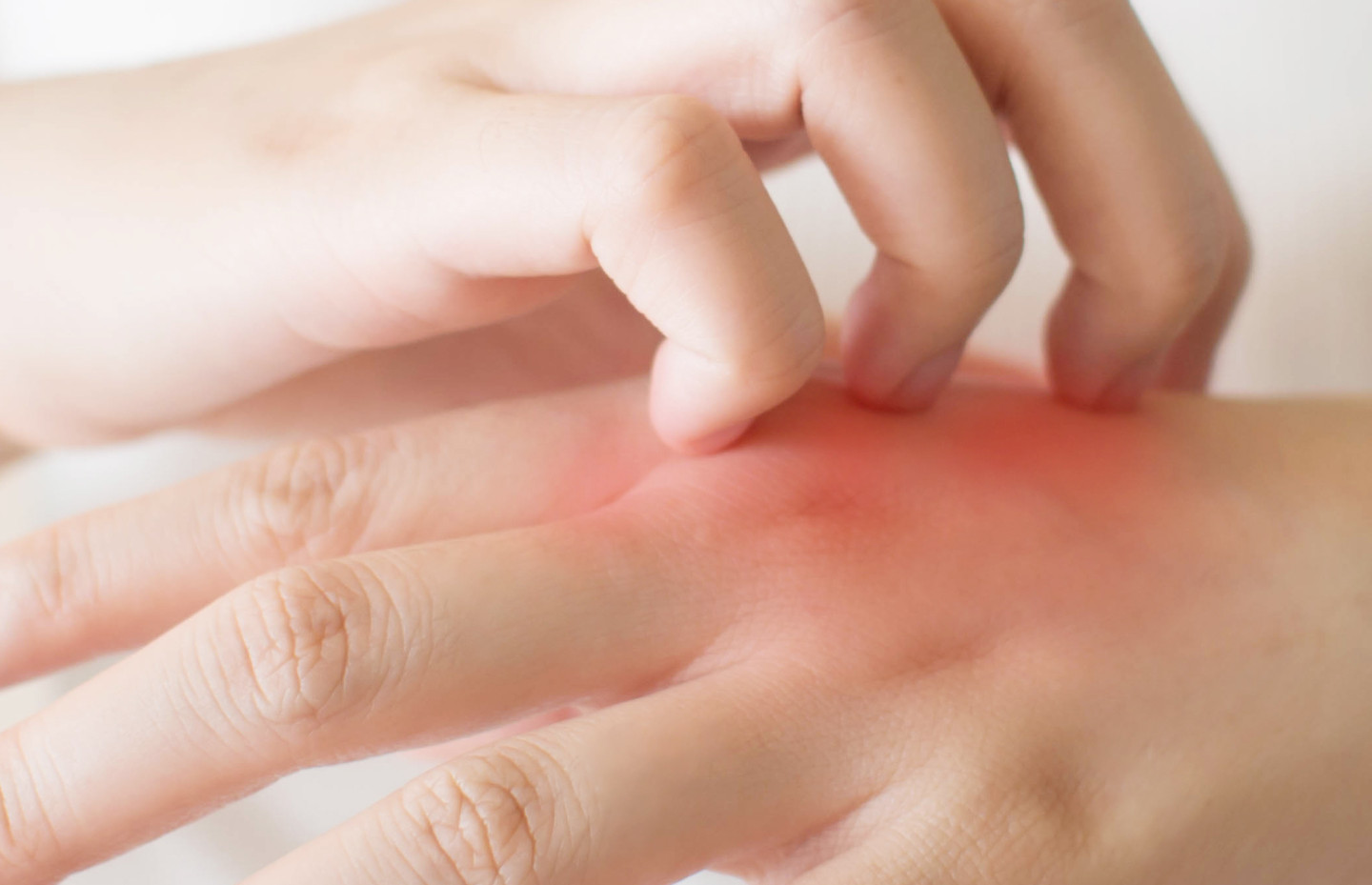
Частые кожные проявления при COVID-19
Самый распространенный вариант кожных проявлений нового коронавируса — эритематозно-отечные очаги. Это пятна разного диаметра и всевозможных оттенков красного. Они не чешутся, но пораженная кожа на ощупь становится теплой или даже горячей.
«Розовые» высыпания — шелушащиеся пятна овальной формы чаще всего располагаются на боковых поверхностях туловища и могут доставлять дискомфорт из-за зуда.
Кожные проявления встречаются не хаотично: многие из них характерны для определенной возрастной группы пациентов или тяжести течения болезни.
Тяжелое течение COVID-19
Акро-ишемия поражает кончики пальцев, подушечки стоп или кожу пяточной области. Тяжелое течение COVID-19 может привести к гиперкоагуляции — чрезмерному сгущению крови. Она с трудом проходит по кровеносным сосудам, особенно мелким — капиллярам и венулам, что приводит к их повреждениям, застоям крови и образованию кровяных сгустков — тромбов.
Высыпание по типу крапивницы (уртикарной сыпи) может появиться раньше «классических» симптомов коронавируса в виде кашля и лихорадки. У детей крапивница появлялась в 19% случаев от общего числа зараженных коронавирусом и была связана с более тяжелым течением заболевания, чем у других сверстников. Но не каждая уртикарная сыпь — проявление COVID-19. В этом случае на вирус может указать повышенная температура, которая не характерна для обычной крапивницы.
Чаще всего у пациентов с новым коронавирусом встречается макулопапулезная или пятнисто-папулезная сыпь. Она длится около девяти дней с момента появления и поражает преимущественно бедра, предплечья и плечи.
Средняя тяжесть COVID-19
Сыпь, напоминающую ветрянку, исследователи связывают с промежуточной тяжестью течения коронавируса. Чаще всего такой симптом проявляется у пациентов среднего возраста.
Как и в случае с ветрянкой, сыпь представляет собой мелкие одинаковые пузырьки, которыми усыпана кожа туловища. Но истинная ветряная оспа и подобная ей вирусная экзантема появляются только после контакта с тем, кто уже заражен этими инфекциями.
В случае с COVID-19 такая сыпь длится около десяти дней и исчезает вместе с остальными симптомами, а иногда и раньше них.
Легкая форма COVID-19
Высыпания на пальцах рук и ног, похожие на обморожения, могут появиться при легком течении коронавируса у детей или молодых людей. Средний возраст заболевших с высыпаниями по типу обморожения — 14 лет. Это проявление врачи нашли у 25 пациентов в Испании и 11 детей в на севере Италии. У них не было ни типичных для коронавируса симптомов, ни объективных причин обморожения, а результат анализа на COVID-19 был положительным.
При высыпании по типу обморожения над поверхностью кожи появляются пятна ярко-красного цвета с розово-фиолетовым оттенком. Пораженные участки, как правило, расположены асимметрично, а после выздоровления симптомы безо всякого лечения проходят, не оставляя шрамов.
Сыпь с петехиями, мелкими точечными кровоизлияниями, как и с пурпурной сыпью, не поражала кожу ладоней и стоп, не было проявления и на слизистой полости рта. Не всегда такой симптом свидетельствует о коронавирусе, его могут вызвать и другие инфекционные заболевания или реакция на лекарства. Отличить их помогут биохимические анализы крови и вирусологическое исследование.
Из 27 детей с легкой формой заболевания у двоих развилось таргетоидное (целевое или кольцевое) поражение, напоминающее многоформную эритему. В этом случае округлые пятна имеют красный центр с везикулой, напоминающий мишень. Эти высыпания могут быть сгруппированы между собой. Такая симптоматика характерна для простого герпеса, но никто из заболевших им не страдал.
При таргетоидных поражениях есть три цветовые зоны: темный центр с волдырем или корочкой, бледно-розовая приподнятая из-за отека поверхность вокруг и ярко-красное внешнее кольцо. Таргетоидные поражения появляются на любом участке тела, включая слизистые оболочки, например губы.
Кожные проявления во время пандемии COVID-19 привлекают все большее внимание, поскольку они могут быть полезны для ранней постановки диагноза, особенно у детей и пожилых людей.
Если вы заметили у себя или своего ребенка высыпания, вспомните, не контактировали ли вы с людьми, больными ветрянкой или другими инфекциями с характерной сыпью. Не может ли это быть проявлением аллергии на продукты, косметику или чистящие средства. Если нет, сразу обращайтесь к дерматологу, который точно установит диагноз и назначит лечение.
Сыпь на животе у взрослого человека, которая зудит, либо проявляется без наличия данного симптома, свидетельствует о том, что присутствует обширная аллергическая реакция организма на внешний или внутренний раздражитель. Также наличие высыпаний на поверхности живота может говорить об инфекционном, либо вирусном поражении поверхностного слоя эпителиальной ткани. Независимо от природы происхождения сыпи на животе, необходимо установить точную причину болезненного состояния кожи, чтобы назначить соответствующее лечение. В большинстве случаев терапия дерматологического заболевания такого типа проводится с использованием медикаментов, предназначенных для внешней обработки прыщей.
Существует 9% риска выкидыша, если заболевание заражено в течение первой половины беременности. Мы должны поговорить о псевдогруппе или ложном крупе, который затрагивает детей в возрасте от 6 месяцев до 5 лет, особенно во время простуды. Первый кризис все еще впечатляет. Сценарий почти всегда один и тот же: ребенок с холодом просыпается поздно вечером или рано утром, крича, он едва может дышать. Свист и кашель напоминают хриплый лай. Слизистые оболочки голосовых связок и верхних дыхательных путей воспаляются и опухают.
Ребенок будет безмолвен, кашляет и испытывает трудности с дыханием. Тревога и крики только усугубят проблему. Проконсультируйтесь с ближайшим врачом как можно скорее, если симптомы сохраняются, в противном случае водяной пар быстро смягчит симптомы. Все начинается с серьезного и болезненного воспаления горла, вызванного бактериями, стрептококком, чтобы быть точным. Эта бактериальная инфекция может возникать во всех возрастах, особенно у детей детского сада.
Причины мелкой сыпи на животе у взрослого
Факторами, влияющими на формирование мелкой сыпи на поверхности живота, выступают аллергены, раздражающие иммунную систему взрослого человека, либо болезнетворные микроорганизмы, попавшие в эпидермальные ткани больного. В целом же выделяют следующие причины появления мелкой сыпи на животе у взрослого:
Симптомы Внезапная и высокая лихорадка, сильное воспаление горла, воспаление миндалин. Через несколько дней на подмышках и в области шеи появятся маленькие красные точки, которые вскоре будут распространяться по всему телу. Язык будет ярко-красным и опухшим. Ладони рук и подошвы ног будут обескураживать через 1-3 недели. Спонтанное исцеление без рубцов через несколько дней.
Врач назначит антибиотики для бактериальной инфекции горла. Откройте для себя уход за глазами для мембран! советы Легионеллез: причина, симптомы и рекомендации по лечению Гепатит С: кому следует скринировать? Но только одно наблюдение, если так много смертельных болезней исчезло или почти есть благодаря вакцинам. И есть новая вспышка определенных заболеваний, потому что люди думают, что они больше не существуют и больше не вакцинируют своих детей. Советы Сжигание в глазах? . Инфекционная эритема: редкое и мало заразительное вирусное заболевание.
Без зуда
- Гормональный дисбаланс. Нарушение стабильного уровня мужских и может послужить причиной отрицательной реакции кожи с образованием множественной красной или розовой сыпи на поверхности живота. При этом такие мелкие прыщики не болят и не чешутся, как это обычно бывает в случае инфекционного заражения кожного покрова. По мере стабилизации гормонального фона сыпь исчезает также внезапно, как и появилась. Нарушить гормональный баланс может употребление анаболических стероидов, оральных контрацептивов, лекарственных препаратов, созданных на основе синтетических гормонов.
- Потница. Аутоиммунная реакция организма на и ношение одежды из синтетических волокон, которые не пропускают воздух, а также не впитывают пот. В результате этого продукты потоотделения скапливаются на коже живота и провоцируют локальное раздражение, которое не отличается зудом, но имеет вид множественной красной сыпи с ярко выраженными краями каждого прыща. Соблюдение личной гигиены, своевременное принятие водных процедур, а также ношение одежды, выполненной из натуральных тканей, позволяет избежать данных патологических симптомов.
- Прием лекарственных средств. в виде образования множественной кожной сыпи без признаков зуда. В связи с метаболизмом препарата в органах пищеварительной системы, проявляются высыпания именно на поверхности живота. Данную реакцию организма нельзя отнести к признакам аллергии, если производителем лекарства указано, что сыпь это всего лишь побочный эффект. Несмотря на это рекомендуется посетить врача дерматолога и пройти у него консультацию, чтобы избежать возможных проблем со здоровьем. Вполне возможно, что доктор посоветует прекратить прием лекарственных средств, негативно отображающихся на здоровье кожного покрова живота.
С зудом
Красная и розовая сыпь на животе у взрослого мужчины или женщины, которая сопровождается сильным зудом, практически во всех случаях имеет инфекционную или вирусную природу происхождения. Исключением является только аллергическая реакция. Причины высыпаний на животе с зудом заключаются в следующих патогенных факторах:
Инфекционная эритема — редкое вирусное заболевание с небольшой инфекцией. Он обычно поражает детей от 6 до 15 лет. Инфекционная эритема передается при вдыхании капель. Вот почему в детских садах и детских садах регулярно разрастаются небольшие эпидемии.
В общем, инфекционная эритема бессимптомна и оставляет иммунитет для жизни. Осложнения могут возникать у беременных женщин, у которых никогда не было инфекционной эритемы. В наиболее серьезных случаях беременная женщина выкидывает или рожает мертворожденного ребенка.
Заражение происходит зараженными каплями. Беременная женщина передает вирус своему ребенку. Вирус размножается в стволовых клетках эритроцитов в костном мозге. Нарушения гематопоэза могут возникать, что приводит к острой анемии, главным образом у детей или людей с хронической анемией.
В данном случае представлен перечень основных причин появления сыпи на животе у взрослых людей, которые наиболее часто встречаются в дерматологической практике. В силу индивидуальности организма каждого пациента и разнообразия инфекционных микроорганизмов, возможно наличие и других факторов, провоцирующих высыпания с зудом и без него.
Инфекционная эритема относительно редка. Вот почему половина взрослых не была иммунизирована против вируса, что особенно опасно для беременных женщин. Симптомы наблюдаются только у одной четверти инфицированных. У других пациентов болезнь протекает бессимптомно. Инкубационный период длится от 7 до 18 дней. За последние несколько дней инфекция наиболее велика. Как только появляется сыпь, субъект уже не заразителен.
Инфекция развивается в два этапа
Обычно бессимптомный; редко: симптомы, похожие на холодность, такие как кашель, простуда, головная боль, боль в мышцах, легкая лихорадка, озноб. Появление сыпи в виде кругов и типичных гирлянд, сначала на лице, затем на руках, ногах и ягодицах. Анамнез с учетом симптомов Определение антител, направленных
Откуда берётся сыпь на теле и что с этим делать
Сыпь на теле — распространённое явление. Чаще всего она не вредит здоровью: мелкие красные пятнышки, прыщики, пузырьки портят внешний вид, чешутся, но довольно быстро исчезают сами собой.
Однако иногда высыпания могут быть симптомами серьёзных и даже опасных для жизни нарушений.
Когда надо срочно обратиться к врачу
Как можно быстрее идите к терапевту, дерматологу, в ближайшее отделение неотложной помощи или вызывайте скорую помощь, если :
- Сыпь распространилась по всему телу.
- Сыпь сопровождается жаром. Температура выше 38,3 °C указывает на острый воспалительный процесс.
- Сыпь на теле появилась внезапно и становится всё гуще. Это может быть признаком мощной аллергической реакции, которая рискует перерасти в отёк Квинке или даже анафилактический шок. Будьте особенно внимательными, если сыпь появилась в районе лица и шеи. Если заметите, что становится сложно дышать, немедленно набирайте 103 или 112.
- Сыпь идёт пузырьками. То есть на месте многочисленных красных пятнышек начинают появляться наполненные жидкостью пузыри.
- К высыпаниям больно прикасаться.
- Сыпь на теле сильно зудит, и вы легко расчёсываете её до крови. В этом случае есть риск занести в ранки инфекцию и получить заражение крови.
Если угрожающих симптомов нет, выдыхайте. Скорее всего, ничего страшного с вами не происходит.
Сейчас читают 🔥
Каковы причины сыпи на теле
Зачастую с ходу определить, откуда взялись высыпания, сложно. Вот несколько наиболее распространённых вариантов .
Укусы насекомых
Открыть изображение
Закрыть
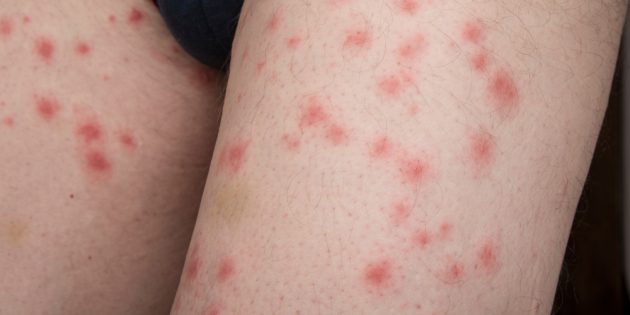 Фото: Maxop‑Plus / Shutterstock
Фото: Maxop‑Plus / Shutterstock
Укус комара или, положим, пчелы опознать легко: на его месте возникает округлая плотная припухлость, которая чешется или болит. С сыпью такое повреждение кожи не перепутаешь. Но есть насекомые, чьи укусы похожи на высыпания. Это, например, блохи — постельные или песчаные.
Если зудящие красные точки на коже вы обнаружили с утра или после пляжа, возможно, вас искусали.
Фотоаллергия
Открыть изображение
Закрыть
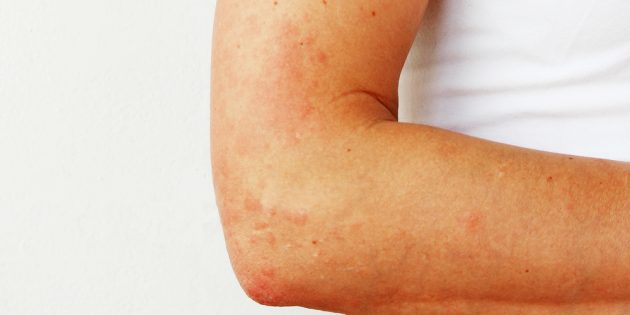 Фото: wolfness72 / Shutterstock
Фото: wolfness72 / Shutterstock
Она же — аллергическая реакция на ультрафиолет («солнечное отравление»). Сыпь при этом может быть разной:
- мелкие зудящие покраснения;
- прыщики телесного цвета, на ощупь похожие на наждачную бумагу;
- волдыри;
- пятна отчётливого красного цвета, стремящиеся слиться в единое целое.
Чаще всего аллергия на солнце возникает из‑за того, что при загаре на коже присутствовало какое‑то вредное вещество — крем, лосьон, лекарственное средство, сок растения — и ультрафиолет превратил его в аллерген. Другой вариант: вы принимаете лекарство, из‑за которого кожа стала чувствительной к солнцу.
Контактный дерматит
Открыть изображение
Закрыть
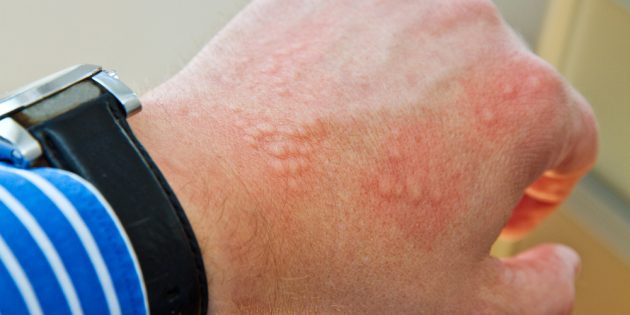 Фото: Juergen Faelchle / Shutterstock
Фото: Juergen Faelchle / Shutterstock
Возникает, когда на кожу попадает какое‑то токсичное вещество (аллерген) и эпидермис в ответ реагирует раздражением и высыпаниями. Аллергенами нередко выступают:
- Сок или пыльца некоторых растений, например ядовитого плюща или крапивы. Кожная реакция на пыльцу крапивы настолько распространена, что характерную сыпь на коже называют крапивницей.
- Латекс.
- Некоторые металлы, которые могут содержаться в бижутерии, заколках для волос, брелоках для ключей. Чаще всего аллергия возникает на никель, кобальт, хром, медь.
- Различные косметические продукты — от кремов до туалетной воды.
- Красители в дешёвой одежде.
Аллергия на лекарства
Открыть изображение
Закрыть
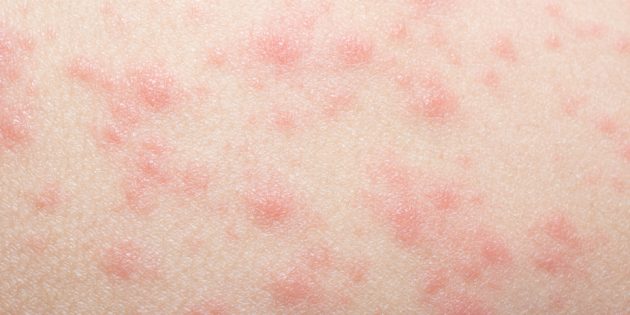 Фото: ARZTSAMUI / Shutterstock
Фото: ARZTSAMUI / Shutterstock
Высыпания и зуд могут быть побочными эффектами некоторых препаратов, например антибиотиков. Если вы недавно начали принимать новое лекарство, загляните в инструкцию. Заодно проверьте, нет ли там упоминания о том, что препарат имеет фотосенсибилизирующий (то есть повышающий чувствительность к солнечному свету) эффект.
Поллиноз
Открыть изображение
Закрыть
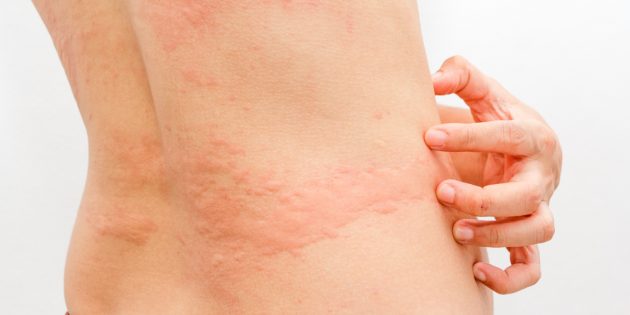 Фото: namtipStudio / Shutterstock
Фото: namtipStudio / Shutterstock
Он же — аллергия на пыльцу. Этот вариант можно заподозрить, если сыпь появилась на фоне других признаков аллергической реакции:
- насморка;
- слезящихся глаз;
- навязчивого кашля или чихания.
Пищевая аллергия
Открыть изображение
Закрыть
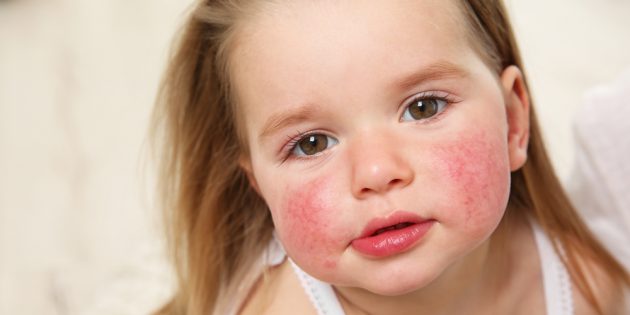 Фото: Africa Studio / Shutterstock
Фото: Africa Studio / Shutterstock
Может проявлять себя как крапивницей, появляющейся на разных участках тела, так и алыми высыпаниями на щеках (этот симптом более характерен для маленьких детей).
Самыми распространёнными продуктами‑аллергенами считаются :
- яйца;
- молоко;
- арахис и лесные орехи;
- рыба и ракообразные;
- пшеница;
- соя.
Инфекции кожи
Сыпь может появляться из‑за бактерий, грибков, вирусов, атакующих эпидермис.
Например, при стригущем лишае возникают округлые зудящие пятна с яркой каймой. Эта грибковая инфекция, вопреки стереотипам, может атаковать не только волосистую часть головы, но и любой другой участок кожи.
Открыть изображение
Закрыть
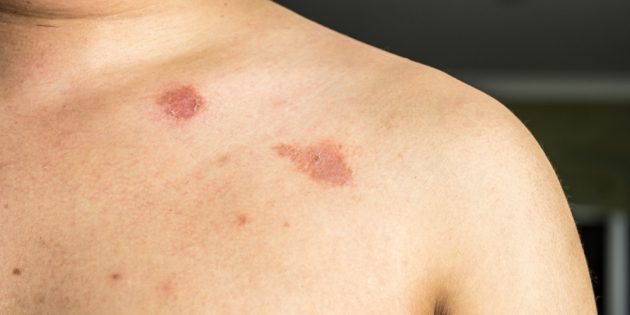 Фото: Phubes Juwattana / Shutterstock
Фото: Phubes Juwattana / Shutterstock
Пример вирусной инфекции — контагиозный моллюск. Это заболевание даёт о себе знать выпуклыми красновато‑коричневыми и, что важно, твёрдыми бугорками диаметром 1–5 мм, которые могут появиться на любом участке тела. Несмотря на название, никакой моллюск под кожей не живёт. Это реакция кожи на вирус.
Открыть изображение
Закрыть
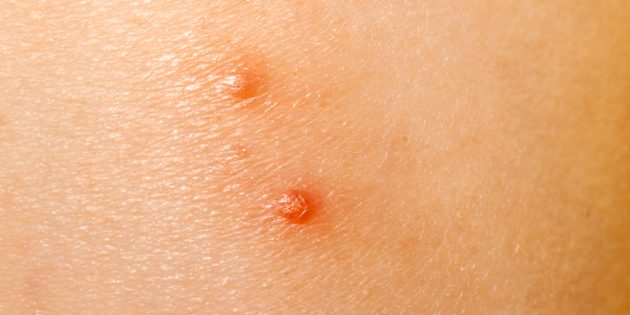 Фото: Lukassek / Shutterstock
Фото: Lukassek / Shutterstock
Что делать, если появилась сыпь на теле
Симптомы, при которых надо как можно быстрее обратиться к врачу, описаны выше. Если у вас их нет, можно попробовать справиться с сыпью в домашних условиях .
- Следите за чистотой кожи. Утром, вечером и по мере загрязнения аккуратно промывайте её тёплой водой и мягким мылом без запаха. Пока сыпь не сойдёт, откажитесь от использования жёстких мочалок и щёток.
- Носите одежду из мягких и дышащих тканей. Раздражённая кожа должна дышать.
- Контролируйте влажность воздуха в помещении, где вы находитесь. Оптимальное значение — 40–60%.
- Исключите из рациона продукты — потенциальные аллергены.
- Если сыпь возникла после того, как вы начали пользоваться новой косметикой, на время откажитесь от неё. И проследите за своим состоянием.
- Увлажняйте кожу. Это уменьшит зуд и поможет эпидермису быстрее восстановиться. Лучше всего наносить увлажняющие средства сразу после душа или ванны. Пользуйтесь только гипоаллергенными кремами, лосьонами или гелями.
Если зуд настолько силён, что вы не можете о нём забыть, проконсультируйтесь с дерматологом или терапевтом. Врач порекомендует антигистаминные лекарства или аптечные мази, которые помогут снизить неприятные ощущения.
Обратиться к врачу стоит и в том случае, если сыпь не уменьшается спустя день‑два или кажется вам необычной, необъяснимой, вызывает беспокойство. Медик поставит точный диагноз и назначит наиболее эффективное лечение.
Читайте также 🧐
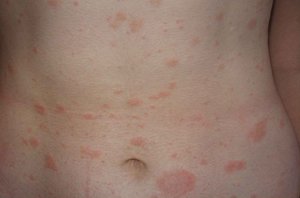 На поверхности кожи образовались красные высыпания. Человек встревожен и начинает испытывать зуд и другие неприятные ощущения. Появляются следующие вопросы: чем спровоцировано высыпание на руках, ногах, животе, и как его вылечить, необходима ли помощь врача-дерматолога?
На поверхности кожи образовались красные высыпания. Человек встревожен и начинает испытывать зуд и другие неприятные ощущения. Появляются следующие вопросы: чем спровоцировано высыпание на руках, ногах, животе, и как его вылечить, необходима ли помощь врача-дерматолога?
Какие бывают виды сыпи?
Высыпания на теле у взрослого человека объясняется рядом характерных причин. Сыпь может быть неинфекционной (появление аллергии, в результате болезни сосудов или сердца, из-за несоблюдения правил гигиены тела и так далее) и инфекционной.
Неинфекционная аллергическая сыпь:
 Дерматит стасис. Водянистая сыпь на поверхности кожи. Ее также называют пузырьковым высыпанием, поскольку внутри волдырей скапливается жидкость. Чаще всего эта сыпь склонна к локализации на ногах и животе. При этом воспалении из-за нарушения кровообращения появляется постоянный зуд и отечность.
Дерматит стасис. Водянистая сыпь на поверхности кожи. Ее также называют пузырьковым высыпанием, поскольку внутри волдырей скапливается жидкость. Чаще всего эта сыпь склонна к локализации на ногах и животе. При этом воспалении из-за нарушения кровообращения появляется постоянный зуд и отечность.- Дерматит контактный. Высыпания красного цвета, вызванные непосредственным контактом с аллергическими элементами или раздражителями, провоцирующие зуд покрова кожи. Единичные химические вещества могут быть как раздражителями, так и аллергенами. При этом виде заболевания сыпь образуется на всем теле. Часто причиной сыпи является аллергия на косметические средства или украшения из металла, различную растительность, при этом больной начинает чесаться. Украшения, которые содержат никель, чаще всех провоцируют аллергическое высыпание.
- Дерматит атопический, также называется экземой. Проявляется у людей, которые имеют астму или болеют осенней горячкой. Основной признак болезни – сильный зуд и красные волдыри. Они находятся в районе лодыжек, запястий, а также на шее, животе и лице. Зуд может быть не только очень сильным, но и сопровождаться сильными болями, пациент все время чешется.
Для профилактики аллергического высыпания ведут здоровый образ жизни, укрепляют иммунитет, придерживаются диеты. Если образования на коже у взрослого это аллергия на продукты, то нужно обратиться к гастроэнтерологу.
Другие виды неинфекционных высыпаний
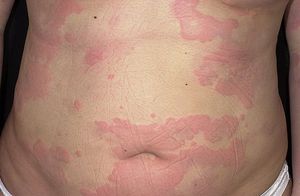 Монетовидная экзема. Ее не относят к «неинфекционной аллергии покрова кожи», поскольку причина образования находится в нарушении нервной и эндокринной системы, а аллергические раздражители лишь усугубляют заболевание, но не могут ее спровоцировать.
Монетовидная экзема. Ее не относят к «неинфекционной аллергии покрова кожи», поскольку причина образования находится в нарушении нервной и эндокринной системы, а аллергические раздражители лишь усугубляют заболевание, но не могут ее спровоцировать.
Главная особенность появления монетовидной экземы – сыпь с наличием гнойничков на коже, имеющие форму волдырей и сильный зуд.
Волдыри, локализуясь на покрове кожи, образуют кластеры, которые имеют вид монеты, отсюда и название заболевания – монетовидная экзема. Отдельные пациенты отмечали, что небольшие водяные высыпания проявлялись с гноем, находящимся в полости непосредственно волдыря.
Красные высыпания с присутствием гноя склонны проявляться в зимнее время, и кожа на их месте начинает сильно чесаться. Зимой коже не хватает полезных витаминов и влаги, покров кожи становится сухим, как итог — образуется сыпь.
Псориаз. Причины появления этого заболевания пока еще полностью не выяснены, врачи считают это аутоиммунным проявлением болезни. Подобному дерматиту заболевание сопровождается сыпью на теле в виде ровных папул различной величины.
Через время, после высыпаний, папулы группируются, и формируются бляшки розового или красно цвета. Их постепенно покрывает белая плотная корка.
Неинфекционные высыпания от пота, от воздействия солнца, после моря
Очень часто во время жары летом на покрове кожи образуются белые новообразования. Может показаться, что кожа покрылась небольшими белыми пузырьками.
Это высыпание на теле вызвано чрезмерной активностью потовых желез с последующим закупориванием. Высыпания могут быть сильными или в виде единичных элементов. Это возможно и проявление крапивницы.
Правильней говорить, что это красное высыпание на теле от пота, а не от действия лучей солнца, но активная работа на солнце активизирует работу желез в повышенном режиме. Эти высыпания могут проявляться и в виде сыпи после принятия гигиенических водных процедур.
Все вышеперечисленные варианты высыпания являются проявлением одного заболевания – потницы. Она не является опасной, но иногда сопровождается определенными неудобствами. Зачастую к потнице добавляются различные инфекции.
Они активизируют высыпание на коже, по всему покрову, увеличивается температура тела, образуется красная сыпь или водянистые новообразования.
Инфекционные высыпания на коже
Заражение грибками
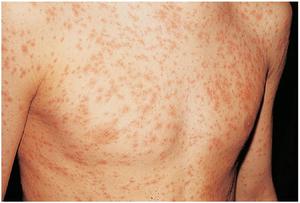 Зудящая мелкая сыпь на коже. Изначальная причина этого – наличие грибковой инфекции. Нужно отметить, что если образовалась эта мелкая сыпь на коже в форме чешуек, то в этом случае заключение только одно – «грибковое поражение». Но не все виды чешуйчатого высыпания образуются из-за наличия грибка.
Зудящая мелкая сыпь на коже. Изначальная причина этого – наличие грибковой инфекции. Нужно отметить, что если образовалась эта мелкая сыпь на коже в форме чешуек, то в этом случае заключение только одно – «грибковое поражение». Но не все виды чешуйчатого высыпания образуются из-за наличия грибка.
К примеру, мелкая сыпь в форме чешуек на животе, руках и ногах – это проявление различных видов дерматита, который зудит и чешется, его часто неверно определяют, как стригущий лишай. Если развивается кожный грибок и образуется сыпь из-за него, это не совершенно не обозначает, что человек не следит за собственной гигиеной.
Невзирая на то, что этот вывод является верным, грибки могут появляться и у «чистюль». От домашних животных к человеку грибковый вирус не переходит, также в общественном месте грибком тоже нечасто заражаются.
Бактериальное поражение
Импетиго – это распространенная инфекция, которая передается бактериальным способом. Возбудители болезни – это стрептококки и стафилококки. При этом заболевании сыпь очень болезненна и может сопровождаться зудом на всем участке высыпаний.
Вирусные заражения
Вирусное высыпание характеризуется слабой или обильной сыпью по всему покрову кожи. К вирусным инфекциям относятся опоясывающий лишай, а также ветрянка в виде красных точек. Данные высыпания проходят самостоятельно. Для лечения заболевания используют препараты, которые уменьшают зуд.
Менингит – тяжелая форма инфекционного заболевания
Менингит – это довольно опасное и серьезное заболевание, но проявления высыпаний – не первая причина болезни. Менингит склонен появляться позже, его сразу определить недуг невозможно. При этой болезни проявляются мелкие высыпания фиолетового или красного цвета.
Они не возвышаются над покровом кожи и не меняются в цвете при сильном надавливании. Этим и характеризуется менингит, поскольку при других поражениях при нажатии сыпь проходит совсем или становится бледной. При поражении менингитом сыпь увеличивается, становится в форме пятен и проявляется на чистых участках.
Как вылечить высыпания?
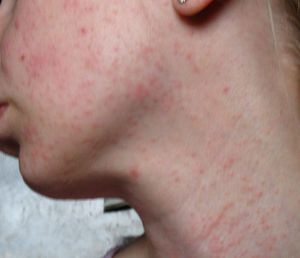 Основное требование – это обращение за помощью к врачу, поскольку описание высыпаний не все время соответствует виды заболевания. Сыпь может быть различных видов, потому точно узнать причину и характер высыпания и может лишь специалист. С учетом полученных анализов прописывается соответствующая терапия болезни.
Основное требование – это обращение за помощью к врачу, поскольку описание высыпаний не все время соответствует виды заболевания. Сыпь может быть различных видов, потому точно узнать причину и характер высыпания и может лишь специалист. С учетом полученных анализов прописывается соответствующая терапия болезни.
Чтобы снять зуд и избавиться от дискомфорта, используют следующие препараты без рецепта:
- лосьоны для увлажнения кожи;
- антигистаминные средства;
- препараты в виде мазей.
Антигистаминные препараты могут снизить уровень работоспособности, вызвать слабое и вялое состояние, потому их назначают очень осторожно.
Нужно не забывать, что при образовании любого типа сыпи нужно немедленно обратиться к врачу. Так как проявление высыпаний может являться причиной серьезных патологических процессов, которые потребуют незамедлительного вмешательства. Необходимо очень внимательно относиться к состоянию вашей кожи и начинать лечить заболевание на ранних этапах развития. Так как это дешевле, проще и безопасней.
Сыпь на теле у взрослых
90000 22 Common Skin Rashes, Pictures, Causes, and Treatment 90001 90002 We include products we think are useful for our readers. If you buy through links on this page, we may earn a small commission. Here’s our process. 90003 90002 A rash is a noticeable change in the texture or color of your skin. Your skin may become scaly, bumpy, itchy, or otherwise irritated. 90003 90002 There are many different causes for rashes. Here’s a list of 21 with pictures. 90003 90008 Warning: graphic images ahead.90009 90010 Flea bites 90011 90012 90013 usually located in clusters on the lower legs and feet 90014 90013 itchy, red bump surrounded by a red halo 90014 90013 symptoms begin immediately after being bitten 90014 90019 90002 Read full article on flea bites. 90003 90022 90010 Fifth disease 90011 90012 90013 headache, fatigue, low fever, sore throat, runny nose, diarrhea, and nausea 90014 90013 children are more likely than adults to experience a rash 90014 90013 round, bright red rash on the cheeks 90014 90013 lacy -patterned rash on the arms, legs, and upper body that might be more visible after a hot shower or bath 90014 90019 90002 Read full article on fifth disease.90003 90022 90010 Rosacea 90011 90012 90013 chronic skin disease that goes through cycles of fading and relapse 90014 90013 relapses may be triggered by spicy foods, alcoholic beverages, sunlight, stress, and the intestinal bacteria 90044 Helicobacter pylori 90045 90014 90013 the four subtypes of rosacea encompass a wide variety of symptoms 90014 90013 common symptoms include facial flushing, raised, red bumps, facial redness, skin dryness, and skin sensitivity 90014 90019 90002 Read full article on rosacea.90003 90022 90010 Impetigo 90011 90012 90013 common in babies and children 90014 90013 often located in the area around the mouth, chin, and nose 90014 90013 irritating rash and fluid-filled blisters that pop easily and form a honey-colored crust 90014 90019 90002 Read full article on impetigo. 90003 90022 90010 Ringworm 90011 90012 90013 circular-shaped scaly rashes with raised border 90014 90013 skin in the middle of the ring appears clear and healthy, and the edges of the ring may spread outward 90014 90013 itchy 90014 90019 90002 Read full article on ringworm.90003 90022 90010 Contact dermatitis 90011 90012 90013 appears hours to days after contact with an allergen 90014 90013 has visible borders and appears where your skin touched the irritating substance 90014 90013 skin is itchy, red, scaly, or raw 90014 90013 blisters that weep, ooze , or become crusty 90014 90019 90002 Read full article on contact dermatitis. 90003 90022 90010 Allergic eczema 90011 90012 90013 may resemble a burn 90014 90013 often found on hands and forearms 90014 90013 skin is itchy, red, scaly, or raw 90014 90013 blisters that weep, ooze, or become crusty 90014 90019 90002 Read full article on allergic eczema.90003 90022 90010 Hand, foot, and mouth disease 90011 90012 90013 usually affects children under age 5 90014 90013 painful, red blisters in the mouth and on the tongue and gums 90014 90013 flat or raised red spots located on the palms of the hand and soles of the feet 90014 90013 spots may also appear on the buttocks or genital area 90014 90019 90002 Read full article on hand, foot, and mouth disease. 90003 90022 90010 Diaper rash 90011 90012 90013 located on areas that have contact with a diaper 90014 90013 skin looks red, wet, and irritated 90014 90013 warm to the touch 90014 90019 90002 Read full article on diaper rash.90003 90022 90010 Eczema 90011 90012 90013 yellow or white scaly patches that flake off 90014 90013 affected areas may be red, itchy, greasy, or oily 90014 90013 hair loss may occur in the area with the rash 90014 90019 90002 Read full article on eczema. 90003 90022 90010 Psoriasis 90011 90012 90013 scaly, silvery, sharply defined skin patches 90014 90013 commonly located on the scalp, elbows, knees, and lower back 90014 90013 may be itchy or asymptomatic 90014 90019 90002 Read full article on psoriasis.90003 90022 90010 Chickenpox 90011 90012 90013 clusters of itchy, red, fluid-filled blisters in various stages of healing all over the body 90014 90013 rash is accompanied by fever, body aches, sore throat, and loss of appetite 90014 90013 remains contagious until all blisters have crusted over 90014 90019 90002 Read full article on chickenpox. 90003 90022 90010 Systemic lupus erythematosus (SLE) 90011 90012 90013 an autoimmune disease that displays a wide variety of symptoms that affect many different body systems and organs 90014 90013 a wide array of skin and mucous membrane symptoms that range from rashes to ulcers 90014 90013 classic butterfly-shaped face rash that crosses from cheek to cheek over the nose 90014 90013 rashes may appear or get worse with sun exposure 90014 90019 90002 Read full article on systemic lupus erythematosus (SLE).90003 90022 90012 90013 very painful rash that may burn, tingle, or itch, even if there are no blisters present 90014 90013 clusters of fluid-filled blisters that break easily and weep fluid 90014 90013 rash emerges in a linear stripe pattern that appears most commonly on the torso, but may occur on other parts of the body, including the face 90014 90013 may be accompanied by low fever, chills, headache, or fatigue 90014 90019 90002 Read full article on shingles. 90003 90022 90010 Cellulitis 90011 90002 90209 This condition is considered a medical emergency.Urgent care may be required. 90210 90003 90012 90013 caused by bacteria or fungi entering through a crack or cut in the skin 90014 90013 red, painful, swollen skin with or without oozing that spreads quickly 90014 90013 hot and tender to the touch 90014 90013 fever, chills, and red streaking from the rash might be a sign of serious infection requiring medical attention 90014 90019 90002 Read full article on cellulitis. 90003 90022 90010 Drug allergy 90011 90002 90209 This condition is considered a medical emergency.Urgent care may be required. 90210 90003 90012 90013 mild, itchy, red rash may occur days to weeks after taking a drug 90014 90013 severe drug allergies can be life-threatening and symptoms include hives, racing heart, swelling, itching, and difficulty breathing 90014 90013 other symptoms include fever , stomach upset, and tiny purple or red dots on the skin 90014 90019 90002 Read full article on drug allergies. 90003 90022 90010 Scabies 90011 90012 90013 symptoms may take four to six weeks to appear 90014 90013 extremely itchy rash may be pimply, made up of tiny blisters, or scaly 90014 90013 raised, white, or flesh-toned lines 90014 90019 90002 Read full article on scabies.90003 90022 90010 Measles 90011 90012 90013 symptoms include fever, sore throat, red, watery eyes, loss of appetite, cough, and runny nose 90014 90013 red rash spreads from the face down the body three to five days after first symptoms appear 90014 90013 tiny red spots with blue-white centers appear inside the mouth 90014 90019 90002 Read full article on measles. 90003 90022 90010 Tick bite 90011 90012 90013 pain or swelling at the bite area 90014 90013 rash, burning sensation, blisters, or difficulty breathing 90014 90013 the tick often remains attached to the skin for a long time 90014 90013 bites rarely appear in groups 90014 90019 90002 Read full article on tick bites.90003 90022 90010 Seborrheic eczema 90011 90012 90013 yellow or white scaly patches that flake off 90014 90013 affected areas may be red, itchy, greasy, or oily 90014 90013 hair loss may occur in the rash area 90014 90019 90002 Read full article on seborrheic eczema. 90003 90022 90010 Scarlet fever 90011 90012 90013 occurs at the same time as or right after a strep throat infection 90014 90013 red skin rash all over the body (but not the hands and feet) 90014 90013 rash is made up of tiny bumps that make it feel like «sandpaper» 90014 90013 bright red tongue 90014 90019 90002 Read full article on scarlet fever.90003 90022 90010 Kawasaki disease 90011 90002 90209 This condition is considered a medical emergency. Urgent care may be required. 90210 90003 90012 90013 usually affects children under age 5 90014 90013 red, swollen tongue (strawberry tongue), high fever, swollen, red palms and soles of the feet, swollen lymph nodes, bloodshot eyes 90014 90013 may cause severe heart problems so consult a doctor if there’s concern 90014 90013 however, usually gets better on its own 90014 90019 90002 Read full article on Kawasaki disease.90003 90010 Contact dermatitis 90011 90002 Contact dermatitis is one of the most common causes of rashes. This type of rash occurs when the skin comes into direct contact with a foreign substance that causes an adverse reaction, leading to a rash. The resulting rash may be itchy, red, or inflamed. Possible causes of contact dermatitis include: 90003 90012 90013 beauty products, soaps, and laundry detergent 90014 90013 dyes in clothing 90014 90013 coming into contact with chemicals in rubber, elastic, or latex 90014 90013 touching poisonous plants, such as poison oak, poison ivy , or poison sumac 90014 90019 90010 medications 90011 90002 Taking medications may also cause rashes.They can form as a result of: 90003 90010 Other causes 90011 90002 Other possible causes of rashes include the following: 90003 90012 90013 A rash can sometimes develop in the area of a bug bite, such as a flea bite. Tick bites are of particular concern because they can transmit disease. 90014 90013 Eczema, or atopic dermatitis, is a rash that primarily occurs in people with asthma or allergies. The rash is often reddish and itchy with a scaly texture. 90014 90013 Psoriasis is a common skin condition that can cause a scaly, itchy, red rash to form along the scalp, elbows, and joints.90014 90013 Seborrheic eczema is a type of eczema that most often affects the scalp and causes redness, scaly patches, and dandruff. It can also occur on the ears, mouth, or nose. When babies have it, it’s known as crib cap. 90014 90013 Lupus erythematosus is an autoimmune disease that triggers a rash on the cheeks and nose. This rash is known as a «butterfly,» or malar, rash. 90014 90013 Rosacea is a chronic skin condition of unknown cause. There are several types of rosacea, but all are characterized by redness and rash on the face.90014 90013 Ringworm is a fungal infection that causes a distinctive ring-shaped rash. The same fungus that causes ringworm of the body and the scalp also causes jock itch and athlete’s foot. 90014 90013 Diaper rash is a common skin irritation in infants and toddlers. It’s usually caused by sitting too long in a dirty diaper. 90014 90013 Scabies is an infestation by tiny mites that live on and burrow into your skin. It causes a bumpy, itchy rash. 90014 90013 Cellulitis is a bacterial infection of the skin.It usually appears as a red, swollen area that is painful and tender to the touch. If left untreated, the infection causing the cellulitis can spread and become life-threatening. 90014 90019 90010 Causes of rashes in children 90011 90002 Children are particularly prone to rashes that develop as a result of illnesses, such as: 90003 90012 90013 Chickenpox is a virus characterized by red, itchy blisters that form all over the body. 90014 90013 Measles is a viral respiratory infection that causes a widespread rash consisting of itchy, red bumps.90014 90013 Scarlet fever is an infection due to group A 90044 Streptococcus 90045 bacteria that produces a toxin causing a bright red sandpaper-like rash. 90014 90013 Hand, foot, and mouth disease is a viral infection that can cause red lesions on the mouth and a rash on the hands and feet. 90014 90013 Fifth disease is a viral infection that causes a red, flat rash on the cheeks, upper arms, and legs. 90014 90013 Kawasaki disease is a rare but serious illness that triggers a rash and fever in the early stages and can lead to an aneurysm of the coronary artery as a complication.90014 90013 Impetigo is a contagious bacterial infection that causes an itchy, crusty rash, and yellow, fluid-filled sores on the face, neck, and hands. 90014 90019 90002 You can treat most contact rashes, but it depends on the cause. Follow these guidelines to help ease discomfort and speed up the healing process: 90003 90012 90013 Use mild, gentle cleansers instead of scented bar soaps. 90014 90013 Use warm water instead of hot water for washing your skin and hair. 90014 90013 Pat the rash dry instead of rubbing it.90014 90013 Let the rash breathe. If it’s possible, avoid covering it with clothing. 90014 90013 Stop using new cosmetics or lotions that may have triggered the rash. 90014 90013 Apply unscented moisturizing lotion to areas affected by eczema. 90014 90013 Avoid scratching the rash because doing so can make it worse and could lead to infection. 90014 90013 Apply an over-the-counter hydrocortisone cream to the affected area if the rash is very itchy and causing discomfort. Calamine lotion can also help relieve rashes from chickenpox, poison ivy, or poison oak.90014 90013 Take an oatmeal bath. This can soothe the itchiness associated with rashes from eczema or psoriasis. Here’s how to make an oatmeal bath. 90014 90013 Wash your hair and scalp regularly with dandruff shampoo if you have dandruff along with a rash. Medicated dandruff shampoo is commonly available at drugstores, but your doctor can prescribe stronger types if you need them. 90014 90019 90010 Over-the-counter medications 90011 90002 Take acetaminophen (Tylenol) or ibuprofen (Advil) in moderation for mild pain associated with the rash.Talk to your healthcare provider before you start taking these drugs, and avoid taking them for an extended period because they can have side effects. Ask your healthcare provider how long it’s safe for you to take them. You may not be able to take them if you have liver or kidney disease or a history of stomach ulcers. 90003 90002 Call your healthcare provider if the rash does not go away with home treatments. You should also contact them if you’re experiencing other symptoms in addition to your rash and suspect you have an illness.If you do not already have a physician, you can use the Healthline FindCare tool to find a provider near you. 90003 90002 Go to the hospital immediately if you experience a rash along with any of the following symptoms: 90003 90012 90013 increasing pain or discoloration in the rash area 90014 90013 tightness or itchiness in the throat 90014 90013 difficulty breathing 90014 90013 swelling of the face or extremities 90014 90013 fever of 100.4 ° F (38 ° C) or higher 90014 90013 confusion 90014 90013 dizziness 90014 90013 severe head or neck pain 90014 90013 repeated vomiting or diarrhea 90014 90019 90002 Contact your healthcare provider if you have a rash as well as other systemic symptoms including: 90003 90012 90013 joint pain 90014 90013 a sore throat 90014 90013 a fever slightly above 100.4 ° F (38 ° C) 90014 90013 red streaks or tender areas near the rash 90014 90013 a recent tick bite or animal bite 90014 90019 90002 Your healthcare provider will perform a physical exam and inspect your rash. Expect to answer questions about your: 90003 90012 90013 rash 90014 90013 medical history 90014 90013 diet 90014 90013 recent use of products or medications 90014 90013 hygiene 90014 90019 90002 Your healthcare provider may also: 90003 90012 90013 take your temperature 90014 90013 order tests, such as an allergy test or complete blood count 90014 90013 perform a skin biopsy, which involves taking a small sample of skin tissue for analysis 90014 90013 refer you to a specialist, such as a dermatologist, for further evaluation 90014 90019 90002 fYour healthcare provider may also prescribe medication or medicated lotion to relieve your rash.Most people can treat their rashes effectively with medical treatments and home care. 90003 90002 Follow these tips if you have a rash: 90003 90012 90013 Use home remedies to soothe mild contact rashes. 90014 90013 Identify potential triggers for the rash, and avoid them as much as possible 90014 90013 Call your healthcare provider if the rash does not go away with home treatments. You should also contact them if you’re experiencing other symptoms in addition to your rash and suspect you have an illness.90014 90013 Carefully follow any treatments your doctor prescribes. Speak with your healthcare provider if your rash persists or gets worse despite treatment. 90014 90019 90002 Healthline and our partners may receive a portion of revenues if you make a purchase using a link above. 90003 90002 Read the article in Spanish 90003.90000 68 pictures, causes, and treatments 90001 90002 There are a number of potential causes of rashes, including allergies, diseases, reactions, and medications. They can also be caused by bacterial, fungal, viral, or parasitic infections. 90003 90004 90005 Contact dermatitis 90006 90007 90002 One of the most common causes of rashes — contact dermatitis — occurs when the skin has a reaction to something that it has touched. The skin may become red and inflamed, and the rash tends to be weepy and oozy.Common causes include: 90003 90010 90011 dyes in clothes 90012 90011 beauty products 90012 90011 poisonous plants, such as poison ivy and sumac 90012 90011 chemicals, such as latex or rubber 90012 90019 90004 90005 Medications 90006 90007 90002 Certain medications can cause rashes in some people ; this may be a side effect or an allergic reaction. Also, some medications, including some antibiotics, cause photosensitivity — they make the individual more susceptible to sunlight. The photosensitivity reaction looks similar to sunburn.90003 90004 90005 Infections 90006 90007 90002 Infections by bacteria, viruses, or fungi can also cause a rash. These rashes will vary depending on the type of infection. For instance, candidiasis, a common fungal infection, causes an itchy rash that generally appears in skin folds. 90003 90002 It is important to see a doctor if an infection is suspected. 90003 90004 90005 Autoimmune conditions 90006 90007 90002 An autoimmune condition occurs when an individual’s immune system begins to attack healthy tissue.There are many autoimmune diseases, some of which can produce rashes.For instance, lupus is a condition that affects a number of body systems, including the skin. It produces a butterfly-shaped rash on the face. 90003 90002 Rashes come in many forms and develop for many reasons. 90003 90002 However, there are some basic measures that can speed up recovery and ease some of the discomfort: 90003 90010 90011 Use mild soap — not scented. These soaps are sometimes advertised for sensative skin, or for baby skin.90012 90011 Avoid washing with hot water — opt for warm. 90012 90011 Try to allow the rash to breathe. Do not cover with a Band-Aid or bandage. 90012 90011 Do not rub the rash dry, pat it. 90012 90011 If the rash is dry, for instance, in eczema, use unscented moisturizers. 90012 90011 Do not use any cosmetics or lotions that may be causing the rash — for instance, newly purchased items. 90012 90011 Avoid scratching to lessen the risk of infection. 90012 90011 Cortisone creams that can be purchased over-the-counter or online may ease itching.90012 90011 Calamine can relieve some rashes, e.g. poison ivy, chickenpox, and poison oak. 90012 90019 90002 If the rash causes mild pain, acetaminophen or ibuprofen may be useful, but these are not a long-term solution — they will not treat the cause of the rash. 90003 90002 It is important to speak with a doctor before taking any medication. Compare brands before purchasing over-the-counter or online products, to ensure the product is suitable. 90003 90002 If a rash occurs with the following symptoms, it is important to visit a doctor: 90003 90010 90011 a sore throat 90012 90011 pain in joints 90012 90011 if you have had a recent animal or insect bite 90012 90011 red streaks near the rash 90012 90011 tender regions near the rash 90012 90011 a large collection of pus 90012 90019 90002 Although the majority of rashes are not a major cause for concern, anyone experiencing the following symptoms should go to the hospital straight away: 90003 90010 90011 quickly changing coloration on the skin 90012 90011 difficulty breathing or feeling like the throat is closing up 90012 90011 increasing pain or severe pain 90012 90011 high fever 90012 90011 confusion 90012 90011 dizziness 90012 90011 swelling of the face or extremities 90012 90011 severe pain in the neck or head 90012 90011 repeated vomiting or diarrhea 90012 90019 90002 If a rash occurs with the following symptoms, it is important to visit a doctor: 90003 90010 90011 a sore throat 90012 90011 pain in joints 90012 90011 if you have had a recent animal or insect bite 90012 90011 red streaks near the rash 90012 90011 tender regions near the rash 90012 90011 a large collection of pus 90012 90019 90002 Although the majority of rashes are not a major cause for concern, anyone experiencing the following symptoms should go to the hospital straight away: 90003 90010 90011 quickly changing coloration on the skin 90012 90011 difficulty breathing or feeling like the throat is closing up 90012 90011 increasing pain or severe pain 90012 90011 high fever 90012 90011 confusion 90012 90011 dizziness 90012 90011 swelling of the face or extremities 90012 90011 severe pain in the neck or head 90012 90011 repeated vomiting or diarrhea 90012 90019 90004 1.Bites and stings 90007 90002 Many insects can cause a rash through a bite or sting. Although the reaction will vary depending on the person and the animal, symptoms often include: 90003 90010 90011 redness and rash 90012 90011 itching 90012 90011 pain 90012 90011 swelling — either localized to the site of the bite or sting or more widespread 90012 90019 90004 2 . Flea bites 90007 90002 Fleas are tiny jumping insects that can live in fabrics within the home. They have a very fast breeding cycle and can take over a home very rapidly.90003 90010 90011 flea bites on humans often appear as red spots 90012 90011 the skin can become irritated and painful 90012 90011 secondary infections can be caused by scratching 90012 90019 90004 3. Fifth disease 90007 90002 Also known as erythema infectiosum and slapped cheek syndrome, fifth disease is caused by the parvovirus B19. One of the symptoms is a rash, which appears in three stages: 90003 90010 90011 A blotchy red rash on the cheeks with groups of red papules. 90012 90011 After 4 days, a net of red marks may appear on the arms and trunk.90012 90011 In the third stage, the rash only appears after exposure to sunlight or heat. 90012 90019 90004 4. Impetigo 90007 90002 Impetigo is a highly contagious skin infection that most commonly affects children. The first sign is normally a patch of red, itchy skin. There are two types of impetigo: 90003 90010 90011 Non-bullous impetigo — red sores appear around the mouth and nose. 90012 90011 Bullous impetigo — less common, generally affects children under 2. Medium to large blisters appear on the trunk, arms, and legs.90012 90019 90004 5. Shingles 90007 90002 Shingles is an infection of an individual nerve. It is caused by the same virus as chickenpox — the varicella-zoster virus. Symptoms include: 90003 90010 90011 A rash similar to chickenpox in a band around the infected nerve. 90012 90011 Blisters can merge producing a solid red band. 90012 90011 Rash is often painful. 90012 90019 90004 6. Scabies 90007 90002 Scabies is a skin condition caused by a microscopic mite. It is very contagious and spreads easily through person-to-person contact.Symptoms include: 90003 90010 90011 Intense itching — often worse at night. 90012 90011 Rash — appears in lines as the mite burrows. Blisters are sometimes present. 90012 90011 Sores — may appear where the rash has been scratched. 90012 90019 90004 7. Eczema 90007 90002 Eczema is one of the most common skin conditions. It often first develops in childhood. Symptoms depend on the type of eczema and on the age of the individual but they often include: 90003 90010 90011 dry scaly patches on the skin 90012 90011 intensely itchy rash 90012 90011 cracked and rough skin 90012 90019 90004 8.Hay fever 90007 90002 Hay fever, or allergic rhinitis, is an allergic response to pollen. Symptoms can be similar to those of a common cold, such as: 90003 90010 90011 runny nose 90012 90011 watery eyes 90012 90011 sneezing 90012 90019 90002 Hay fever can also cause a rash, similar to hives. These will appear as itchy red patches or eruptions on the skin. 90003 90004 9. Scarlet fever 90007 90002 Scarlet fever is a disease caused by a toxin released by a bacteria — 90245 Streptococcus pyogenes 90246 — the same bacteria that is responsible for Strep throat.Symptoms include a sore throat, rash, and fever. The rash has the following characteristics: 90003 90010 90011 red blotches 90012 90011 blotches turn to fine pink-red rash like sunburn 90012 90011 skin feels rough 90012 90019 90004 10. Rheumatic fever 90007 90002 Rheumatic fever is an inflammatory reaction to a streptococcal infection, such as Strep throat. It most commonly affects children aged 5-15. Symptoms include: 90003 90010 90011 small painless bumps under skin 90012 90011 red skin rash 90012 90011 swollen tonsils 90012 90019 90004 11.Mono (mononucleosis) 90007 90002 Mono, or mononucleosis, is caused by a virus. It is rarely serious, but symptoms can include: 90003 90010 90011 a pink, measle-like rash 90012 90011 body aches 90012 90011 high fevers 90012 90019 90004 12. Ringworm 90007 90002 Ringworm, despite its name, is caused by a fungus. The fungal infection affects the top layer of the skin, scalp, and nails. Symptoms vary depending on the site of the infection, but can include: 90003 90010 90011 itchy, red rash in rings — sometimes slightly raised 90012 90011 small patches of scaly skin 90012 90011 hair near patches breaks away 90012 90019 90004 13.Measles 90007 90002 Measles is a highly contagious disease caused by the rubeola virus. Symptoms include: 90003 90010 90011 a reddish-brown rash 90012 90011 small grayish-white spots with bluish-white centers in the mouth 90012 90011 dry cough 90012 90019 90004 14. Yeast infection (candidiasis) 90007 90002 Candidiasis is a common fungal infection of the genitals. It affects both sexes, but more commonly, women. Symptoms include: 90003 90010 90011 rash 90012 90011 pain and soreness in the genital area 90012 90011 itching, burning, and irritation 90012 90019 90004 15.Stasis dermatitis 90007 90002 Stasis dermatitis is also known as varicose eczema. It develops due to poor circulation and most commonly affects the lower legs. Symptoms include: 90003 90010 90011 varicose veins covered in itchy, dry skin 90012 90011 red, swollen, painful skin, which may weep or crust over 90012 90011 heavy, aching legs after standing for some time 90012 90019 90004 16. German measles 90007 90002 Also known as rubella, German measles are an infection caused by the rubella virus.Symptoms include: 90003 90010 90011 rash — less bright than measles, often begins on the face 90012 90011 inflamed, red eyes 90012 90011 stuffy nose 90012 90019 90004 17. Sepsis 90007 90002 Sepsis, often called blood poisoning, is a medical emergency. It is the result of a wide scale immune response to an infection. Symptoms vary, but can include: 90003 90010 90011 a rash that does not fade under pressure 90012 90011 fever 90012 90011 increased heart rate 90012 90019 90004 18. West Nile virus 90007 90002 West Nile virus is an infection spread by mosquitos.Often, there are no symptoms, but if they do occur, they can include: 90003 90004 19. Lyme disease 90007 90002 Lyme disease is a bacterial infection transmitted to humans by the bite of an infected tick. The symptoms include an erythema migrans rash that often appears in the early stages of the disease. 90003 90010 90011 The rash begins as a small red area that may be warm to the touch but not itchy. 90012 90011 The center loses color, giving it a bull’s-eye appearance. 90012 90011 The rash does not necessarily appear at the site of the tick bite.90012 90019 90004 20. Cellulitis 90007 90002 Cellulitis is a bacterial infection of the deep layer of skin — the dermis. It normally occurs when bacteria enter through a break in the skin. Symptoms include: 90003 90010 90011 Skin sores or rash that starts suddenly and grows quickly. 90012 90011 Warm skin around the redness. 90012 90011 Fever and fatigue. 90012 90019 90004 21. MRSA 90007 90002 MRSA (methicillin-resistant staphylococcus aureus) is a contagious bacterial infection that is resistant to a range of antibiotics.This makes it difficult to treat. Symptoms include: 90003 90010 90011 rash 90012 90011 swelling and tenderness in the affected part of the body 90012 90011 wounds that do not heal 90012 90019 90002 90245 Photo credit: National Institute of Allergy and Infectious Diseases (NIAID) 90246 90003 90004 22. Chickenpox 90007 90002 Chickenpox is an infection by the varicella zoster virus. It is unpleasant, but most people recover within a couple of weeks. Symptoms include: 90003 90010 90011 An itchy rash of small red spots first appears on the face and trunk, and then spreads across the body.90012 90011 Spots then develop blisters on top. 90012 90011 After 48 hours, the blisters cloud and start to dry out. 90012 90019 90004 23. Lupus 90007 90002 Lupus is an autoimmune disease, meaning that the immune system attacks healthy tissue. Symptoms vary widely from person to person, but can include: 90003 90010 90011 Butterfly-shaped rash across the cheeks and the bridge of the nose. 90012 90011 Flaky red spots or a purple, scaly rash on the face, neck, or arms. 90012 90011 Skin sensitivity to the sun.90012 90019 90004 24. Toxic shock syndrome 90007 90002 Toxic shock syndrome is a rare condition sparked by a bacterial infection. It develops quickly and can be life-threatening. All people who have toxic shock syndrome have fever and a rash with the following characteristics: 90003 90010 90011 looks similar to sunburn and covers most of the body 90012 90011 flat not raised 90012 90011 turns white when pressed 90012 90019 90004 25. Acute HIV infection 90007 90002 During the first stages of HIV, levels of the virus in the blood are very high because the immune system has not yet started tackling the infection.Early symptoms include a rash with the following features: 90003 90010 90011 mostly affects the upper part of the body 90012 90011 flat or barely raised small red dots 90012 90011 not generally itchy 90012 90019 90004 26. Hand, foot, and mouth 90007 90002 Hand, foot, and mouth is a childhood illness resulting from a viral infection. Symptoms include: 90003 90010 90011 Rash — flat, non-itchy red blisters on the hands and soles of the feet. 90012 90011 Loss of appetite. 90012 90011 Ulcers on the throat, tongue, and mouth.90012 90019 90002 90245 Image credit: KlatschmohnAcker 90246 90003 90004 27. Acrodermatitis 90007 90002 Acrodermatitis, a type of pustular psoriasis, is also known as Gianotti-Crosti syndrome. It is associated with viral infections. Symptoms include: 90003 90010 90011 itchy purple or red blisters 90012 90011 swollen lymph nodes 90012 90011 bloated abdomen 90012 90019 90004 28. Hookworm 90007 90002 Hookworm is a common intestinal parasite. It can cause a range of complications. Symptoms include: 90003 90010 90011 Skin rash in one particular area that is red, itchy, and raised.90012 90011 Breathing complications. 90012 90011 Extreme tiredness. 90012 90019 90004 29. Kawasaki disease 90007 90002 Kawasaki’s disease is a rare syndrome that affects children. It is characterized by an inflammation of the walls of the arteries throughout the body. Symptoms include: 90003 90010 90011 A rash on the legs, arms, and torso and between the genitals and anus. 90012 90011 A rash on the soles of the feet and palms of the hand, sometimes with peeling skin. 90012 90011 Swollen, chapped, and dry lips.90012 90019 90004 30. Syphilis 90007 90002 Syphilis is a sexually transmitted bacterial infection. The disease is treatable, but will not go away on its own. Symptoms vary depending on the stage of the disease and include: 90003 90010 90011 Initially — painless, firm, and round syphilitic sores (chancres). 90012 90011 Later — non-itchy red / brown rash that starts on the trunk and spreads across the body. 90012 90011 Oral, anal, and genital wart-like sores. 90012 90019 90004 31. Typhoid 90007 90002 Typhoid is caused by a bacterial infection.It is spread quickly by contact with the feces of an infected person. If untreated, 25 percent of cases end in death. Symptoms can include: 90003 90010 90011 Rash — rose-colored spots, especially on the neck and abdomen. 90012 90011 Fever — up to 104 degrees Fahrenheit. 90012 90011 Abdominal pain, diarrhea, and constipation. 90012 90019 90002 90245 Image credit: Charles N. Farmer, CDC / Armed Forces Institute of Pathology, 1964 90246 90003 90004 32. Dengue fever 90007 90002 Dengue fever, also called breakbone fever, is transmitted by mosquitos.The condition ranges from mild to severe. Symptoms can include: 90003 90010 90011 Initially a flat, red rash appears over most of the body. 90012 90011 Later, a secondary rash appears, similar to measles. 90012 90011 Severe joint and muscle aches. 90012 90019 90002 90245 Image credit: calliopejen, 2009 90246 90003 90004 33. Ebola 90007 90002 Ebola is a serious viral disease; it spreads rapidly through families and friends and can often be fatal. Often, a rash is one of the symptoms: 90003 90010 90011 Initially, a short-lived mild rash may be present.90012 90011 Rashes begin to peel and look like sunburn. 90012 90011 Later in the disease, the rash may turn to abscesses. 90012 90019 90004 34. SARS 90007 90002 Severe acute respiratory syndrome (SARS) is a contagious and sometimes fatal respiratory illness. Symptoms can include: 90003 90010 90011 skin rash 90012 90011 chills 90012 90011 stiff muscles 90012 90019 90004 35. Contact dermatitis 90007 90002 Contact dermatitis occurs when the skin comes in contact with an irritant; it is relatively common, and can be unpleasant.Symptoms include: 90003 90010 90011 red, flaky rash that stings 90012 90011 blistered skin 90012 90011 burning sensation 90012 90011 cracked skin 90012 90019 90004 36. Fungal infection 90007 90002 Although some fungi live naturally on the human body, sometimes, they can overtake. Symptoms depend on where the infection strikes, but can include: 90003 90010 90011 a red rash with a circular shape and raised edges 90012 90011 cracking, flaking, or dry peeling of the skin in the infected area 90012 90011 chafing, irritation, itching, or burning in the infected area 90012 90019 90004 37.Drug allergy 90007 90002 Certain people have allergic reactions to prescribed drugs. The body’s immune system mistakenly attacks the medication as if it were a pathogen. Symptoms vary depending on the individual and the drug, but can include: 90003 90010 90011 Rash, including hives 90012 90011 Itchy skin or eyes 90012 90011 Swelling 90012 90019 90004 38. Atypical pneumonia 90007 90002 Also called walking pneumonia, atypical pneumonia is less severe than the typical form. Symptoms can include: 90003 90010 90011 rashes (uncommon) 90012 90011 weakness and fatigue 90012 90011 chest pain, especially when breathing deeply 90012 90019 90004 39.Erysipelas 90007 90002 Erysipelas is a skin infection. It is a form of cellulitis, however, unlike cellulitis, it only affects the upper layers of the skin, rather than deeper tissue. The skin in a particular area becomes: 90003 90010 90011 swollen, red, and shiny 90012 90011 tender and warm to the touch 90012 90011 red streaks above the affected area 90012 90019 90002 90245 Image credit: CDC / Dr. Thomas F. Sellers / Emory University 90246 90003 90004 40. Reye’s syndrome 90007 90002 Reye’s syndrome is rare and most commonly occurs in children.It can cause serious damage to the body’s organs, particularly the brain and liver (image opposite shows fat accumulation in liver cells). Early symptoms include: 90003 90010 90011 Rash on the palms of the hands and feet. 90012 90011 Repeated, heavy vomiting. 90012 90011 Lethargy, confusion, and headaches. 90012 90019 90004 41. Addisonian crisis 90007 90002 Addisonian crisis — also known as an adrenal crisis and acute adrenal insufficiency — is a rare and potentially fatal condition where the adrenal glands stop working correctly.Symptoms include: 90003 90010 90011 skin reactions, including rashes 90012 90011 low blood pressure 90012 90011 fever, chills, and sweating 90012 90019 90004 42. Chemical burns 90007 90002 Chemical burns are relatively common; they can occur when a person comes in direct contact with a chemical or its fumes. Symptoms vary but can include: 90003 90010 90011 skin that appears black or dead 90012 90011 irritation, burning, or redness in the affected area 90012 90011 numbness and pain 90012 90019 90004 43.Colorado tick fever 90007 90002 Colorado tick fever, also known as mountain tick fever and American tick fever is a viral infection that develops after a bite from a Rocky Mountain wood tick. Symptoms can include: 90003 90010 90011 a flat or pimply rash 90012 90011 skin or muscle pain 90012 90011 fever 90012 90019 90004 44. Accidental poisoning by soap products 90007 90002 Some soap products contain strong chemicals. If they are ingested or inhaled, they can cause serious damage. Symptoms can include: 90003 90010 90011 chemical burns on the skin 90012 90011 swelling of the throat, lips, and tongue 90012 90011 difficulty breathing 90012 90019 90004 45.Adult-onset Still’s disease 90007 90002 Adult-onset Still’s disease is a rare inflammatory disorder that usually affects people in their 30s. Symptoms include: 90003 90010 90011 A pink rash, mostly affecting the chest and thighs, which tends to fade quickly. 90012 90011 Joint and muscle pain, commonly affecting the knees, wrists, and ankles. 90012 90011 Enlarged spleen, liver, or lymph nodes. 90012 90019 90004 46. Juvenile idiopathic arthritis 90007 90002 Juvenile idiopathic arthritis is the most common form of arthritis in children; it used to be called juvenile rheumatoid arthritis.Symptoms vary depending on the subtype, but can include: 90003 90010 90011 fleeting rashes 90012 90011 a scaly psoriasis-like rash 90012 90011 spiking fever 90012 90019 90004 47. Histoplasmosis 90007.90000 Visual guide to children’s rashes and skin conditions 90001 90002 AAD. Scabies. American Academy of Dermatology. https://www.aad.org/public/diseases/contagious-skin-diseases/scabies [Accessed September 2019] 90003 90002 AAFP. 2017. Diaper rash. American Academy of Family Physicians. https://familydoctor.org/condition/diaper-rash/ [Accessed September 2019] 90003 90002 AAP. 2019. Baby birthmarks and rashes. American Academy of Pediatrics. https://www.healthychildren.org/English/ages-stages/baby/bathing-skin-care/Pages/Your-Newborns-Skin-Birthmarks-and-Rashes.aspx [Accessed September 2019] 90003 90002 AAP. 2015. Cradle cap. American Academy of Pediatrics. https://www.healthychildren.org/English/ages-stages/baby/bathing-skin-care/Pages/Cradle-Cap.aspx [Accessed September 2019] 90003 90002 Allmon, A, et al. 2015. Common skin rashes in children. American Family Physician 92 (3): 211-6. http://www.aafp.org/afp/2015/0801/p211.html [Accessed September 2019] 90003 90002 CDC. 2019. Hand, foot, and mouth disease. U.S. Centers for Disease Control and Prevention.https://www.cdc.gov/hand-foot-mouth/ [Accessed September 2019] 90003 90002 CDC. 2017. Rubella. U.S. Centers for Disease Control and Prevention. https://www.cdc.gov/rubella/ [Accessed September 2019] 90003 90002 CDC. 2019. Measles (rubeola). U.S. Centers for Disease Control and Prevention. https://www.cdc.gov/measles/ [Accessed September 2019] 90003 90002 March of Dimes. 2013. Newborn jaundice. http://www.marchofdimes.org/baby/newborn-jaundice.aspx [Accessed September 2019] 90003 90002 Mayo Clinic.2018. Baby acne. http://www.mayoclinic.org/diseases-conditions/baby-acne/basics/definition/con-20033932 [Accessed September 2019] 90003 90002 MedlinePlus (ADAM). 2017. Poison ivy, oak, and sumac. https://medlineplus.gov/poisonivyoakandsumac.html [Accessed September 2019] 90003 90002 MedlinePlus (ADAM). 2018. Cold sores. https://medlineplus.gov/coldsores.html [Accessed September 2019] 90003 90002 MedlinePlus (ADAM). 2019. Folliculitis. https://medlineplus.gov/ency/article/000823.htm [Accessed September 2019] 90003 90002 Medscape.2019. Papular urticarial. [Accessed September 2019] 90003 90002 Nemours Foundation. 2019. Chickenpox. http://kidshealth.org/en/parents/chicken-pox.html [[Accessed September 2019] 90003 90002 Nemours Foundation. 2018. Hives. http://kidshealth.org/en/parents/hives.html [Accessed September 2019] 90003 90002 Nemours Foundation. 2019. Warts. http://kidshealth.org/en/parents/wart.html [Accessed September 2019] 90003 90002 Nemours Foundation. 2019. Ringworm. http://kidshealth.org/en/teens/ringworm.html [Accessed September 2019] 90003 .90000 Red Spots on Skin: Causes, Treatments, and More 90001 90002 There are many reasons red spots form on the skin, so it’s often hard to tell exactly what the underlying cause may be. Skin irritation can come from several causes, such as an acute infection or a chronic condition. 90003 90002 To find out exactly what’s behind your red spots, make an appointment with your doctor and have them examined. In the meantime, here are 10 of the most common causes of red spots on the skin. 90003 90002 It can be tough to determine what’s causing red spots on your skin.Here are images of 10 skin conditions that could be the culprit. 90003 90002 Pityriasis rosea is an inflammatory skin condition that produces a red rash. Its exact cause is unknown, but researchers think it might come from a viral infection. 90003 90002 The rash is also called Christmas tree rash because it usually starts with a larger oval-shaped red patch that looks a little like a Christmas tree. 90003 90002 This larger patch appears first and can be found on the chest, back, or abdomen.It’s called the mother patch, and the smaller patches that form on other areas of the body are called the daughter patches. 90003 90002 Patches are oval-shaped, red, and sometimes scaly with a raised border that looks similar to ringworm. In addition to the itchy rash, pityriasis symptoms include: 90003 90016 90017 sore throat 90018 90017 itching that gets worse when the skin gets warm, like during a shower or workout 90018 90017 headache 90018 90017 fever 90018 90025 90002 Pityriasis rosea typically goes away on its own and does not need treatment.But you may want to use home remedies to soothe the itch, like calamine lotion or an oatmeal bath. 90003 90002 Here’s how to make your own oatmeal bath. 90003 90002 Heat rash forms when the pores in your skin get clogged as you sweat. It can happen during exercise or when you’re in hot or humid weather. 90003 90002 If the sweat gets blocked from coming to the surface of your skin, small lumps that look like blisters can form. They might be red or filled with clear liquid. The bumps can feel itchy or painful.90003 90002 Often, heat rash forms in areas where your skin rubs together, like your armpits, or where clothing rubs against the skin. In infants, it can form around the neck. 90003 90002 Heat rash usually goes away when your skin cools off. Uncomfortable symptoms can be treated with ointments and creams, including calamine lotion to soothe the itch and steroid creams for more serious cases. 90003 90002 Skin can react when it comes into contact with something that’s either an allergen or an irritant.Contact dermatitis is a rash that happens after you touch a substance you’re allergic to or that is harsh on skin, like a strong cleaning product. 90003 90002 Whether or not you get contact dermatitis depends on what you’re allergic to or what you’re exposed to. For example, most people are allergic to poison ivy and will develop a rash after touching it. 90003 90002 Common symptoms of contact dermatitis can include: 90003 90016 90017 redness 90018 90017 hives 90018 90017 swelling 90018 90017 burning 90018 90017 itching 90018 90017 blisters that can ooze 90018 90017 crusting or scaling on the skin 90018 90025 90002 Treatment depends on what caused the reaction .You may be able to get relief from over-the-counter creams and antihistamines. If the reaction is severe, you might need to get a prescription from your doctor. 90003 90002 Shingles is a painful rash with blisters that develops on one side of the face or body. It’s caused by the varicella zoster virus (VZV), which is the same virus that causes chickenpox. If you’ve had chickenpox before, the virus can become active years later and cause shingles. 90003 90002 Before the rash develops, you might feel itching or tingling in the area.It usually forms a line on the left or right side of the body with painful blisters that itch and scab over in about 7 to 10 days. 90003 90002 Since shingles is more common in older adults, the Centers for Disease Control and Prevention (CDC) recommends that people age 50 and older get a vaccine to prevent symptoms. 90003 90002 Outbreaks of shingles are treated with antiviral medications to shorten the length of time the rash appears on the body. Pain medications and anti-itch creams can help relieve some of the discomfort.90003 90002 Swimmer’s itch is a rash that comes from being in water that’s infested with a parasite. Snails get infected with the parasite and spread it in ponds, lakes, and oceans. When people swim in the water, the parasites can get on their skin. 90003 90002 For some people, these parasites can trigger a reaction. They cause burning and itching as well as small reddish pimples or blisters. 90003 90002 Swimmer’s itch normally goes away on its own in about a week and does not typically require medical attention.In the meantime, anti-itch creams can help reduce symptoms. 90003 90002 Ringworm is a red, blotchy rash that has a raised border in a circular pattern around it. It’s caused by a fungus and can appear anywhere on the body. Athlete’s foot results from this fungus occurring on the feet. Jock itch is what happens when the fungus affects the groin. 90003 90002 This rash does not go away unless the fungus is killed. Ringworm is also contagious, so you can spread it to others. Your doctor can diagnose ringworm and prescribe antifungal medications to treat it.90003 90002 Atopic dermatitis is a common type of eczema. It often starts in babies and can either go away as the child gets older or flare up throughout the course of adult life. 90003 90002 Researchers are not sure what causes the skin condition. It might be genetic or it might be the immune system’s overreaction to something the body comes in contact with. 90003 90002 Atopic dermatitis can be itchy and painful. Skin becomes dry, red, and cracked. If it’s scratched too much, an infection can form, causing blisters that leak yellow liquid.90003 90002 Treatment for atopic dermatitis involves managing flares and keeping skin moisturized. A doctor can tell you if you have atopic dermatitis and prescribe a medicated cream to reduce symptoms. 90003 90002 Not a lot is known about lichen planus. Researchers are not sure what causes it. 90003 90002 It’s a condition that brings on raised, reddish purple bumps in different areas of the body. The most common areas to find these bumps are on the wrists, back, and ankles. 90003 90002 In areas where patches continue to reappear, the skin can get rough and scaly.These rough patches can also be itchy. 90003 90002 Lichen planus can not be cured, so treatments focus on managing symptoms. Your doctor can provide a proper diagnosis and work to create a treatment plan that may include topical creams, light exposure therapy, and prescription medications. 90003 90002 Psoriasis is an autoimmune disease that causes scaly, itchy patches to form on the skin of elbows, knees, scalp, or anywhere else on the body. Skin cells grow faster than normal in people with psoriasis, which is what creates the thick buildup.This can be very uncomfortable, causing itching and burning. 90003 90002 Researchers are not sure what exactly causes psoriasis. It’s likely a combination of genetics and environmental factors. 90003 90002 There are several types of psoriasis, and each can look slightly different. A doctor can diagnose your condition and help you create a treatment plan. Treatments can include creams and medications applied to the skin, light therapy, and injectable medications. 90003 90002 A drug rash happens when your body has an allergic reaction to a medication.This could be any type of medication, not just topical ones you apply to your skin. 90003 90002 Drug rashes can range from mild to severe. In severe cases, you may need emergency medical attention. 90003 90002 The rash can look different depending on the way a medication reacts with your body. For example, some medications are known to cause small, red bumps, while others may cause scaling and peeling or purple patches. It can also be itchy. 90003 90002 If you’ve recently started a new medication and noticed a rash a few days or a couple of weeks later, see your doctor.They can help you figure out the cause behind the reaction and prescribe steroids or antihistamines to reduce the symptoms. 90003 90002 There are many possible causes for red spots on the skin. Some are triggered by allergies, like contact dermatitis, while others are caused by bacteria, a virus, or an autoimmune condition. 90003 90002 If your symptoms are causing severe discomfort or do not improve after trying an over-the-counter anti-itch cream or pain reliever, see your doctor. They can make a proper diagnosis and recommend a treatment based on the cause of your red spots.90003.
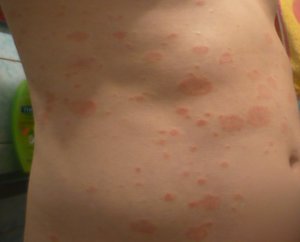 Дерматит стасис. Водянистая сыпь на поверхности кожи. Ее также называют пузырьковым высыпанием, поскольку внутри волдырей скапливается жидкость. Чаще всего эта сыпь склонна к локализации на ногах и животе. При этом воспалении из-за нарушения кровообращения появляется постоянный зуд и отечность.
Дерматит стасис. Водянистая сыпь на поверхности кожи. Ее также называют пузырьковым высыпанием, поскольку внутри волдырей скапливается жидкость. Чаще всего эта сыпь склонна к локализации на ногах и животе. При этом воспалении из-за нарушения кровообращения появляется постоянный зуд и отечность.